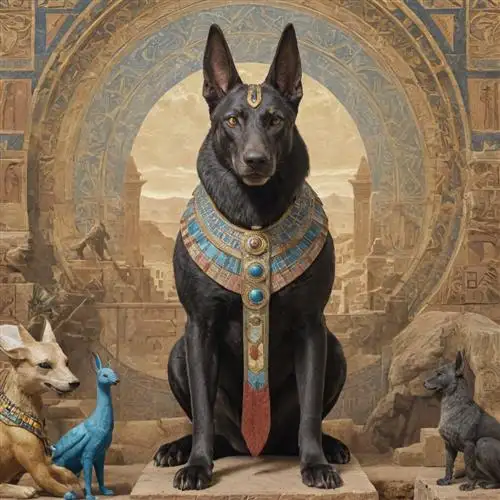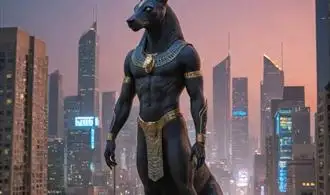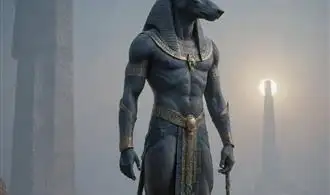
Exploring the Evolving Depictions of Anubis
Anubis, the jackal-headed deity, has long been a captivating figure in ancient Egyptian art and mythology. As one of the most prominent deities in the Egyptian pantheon, Anubis' representation has evolved over centuries, reflecting the shifting cultural and religious beliefs of the civilization. From the earliest known depictions to the more recent interpretations, the artistic renderings of Anubis offer a fascinating glimpse into the rich and complex history of this enigmatic figure.
The earliest known representations of Anubis date back to the Predynastic period, where the deity was often portrayed as a full jackal or a jackal-headed human figure. These early depictions emphasized Anubis' association with death, funeral rites, and the underworld. The jackal-headed form was likely chosen to represent Anubis' role as the guardian of the necropolis and the protector of the dead.
As Egyptian civilization progressed, the artistic interpretations of Anubis became more refined and complex. During the Old Kingdom, Anubis was often depicted standing upright, with the head of a jackal and the body of a human. This representation emphasized Anubis' dual nature, blending the characteristics of both the animal and the divine. Additionally, Anubis was frequently shown performing important funerary rituals, such as embalming the deceased or guiding the soul to the afterlife.
In the New Kingdom, the artistic depictions of Anubis evolved further, with the deity being portrayed in a more dynamic and active manner. Anubis was often shown in scenes of the judgment of the dead, where the deity would weigh the heart of the deceased against the feather of truth. This representation cemented Anubis' role as the overseer of the afterlife, responsible for guiding the souls of the dead to their final resting place.
The Ptolemaic and Roman periods saw a proliferation of Anubis-related artwork, as the deity's popularity and influence spread throughout the Mediterranean world. During this time, Anubis was frequently depicted in a variety of contexts, including temple reliefs, funerary stelae, and even in the form of small statuettes and amulets. These later artistic renderings often incorporated elements of Greco-Roman artistic styles, blending the Egyptian and Hellenistic traditions.
Symbolic Significance of Anubis Imagery
The imagery of Anubis, the ancient Egyptian god associated with mummification and the afterlife, holds deep symbolic significance that has captivated scholars and enthusiasts alike. As a jackal-headed deity, Anubis played a crucial role in the Egyptian funerary rituals, guiding and protecting the deceased on their journey to the afterlife.
At the heart of Anubis' symbolic importance lies his connection to the mummification process. As the god responsible for embalming and preparing the dead for their eternal rest, Anubis represented the delicate balance between life and death. His jackal-like features were believed to symbolize his ability to navigate the liminal space between the mortal and the divine, guiding the deceased through the complex rituals of mummification and into the afterworld.
Moreover, Anubis' role as the weigher of souls in the Judgment of the Dead further solidified his importance in the Egyptian pantheon. During this pivotal moment, Anubis would carefully weigh the heart of the deceased against the feather of Ma'at, the goddess of truth and justice. This ritual, known as the "Weighing of the Heart," was essential in determining the fate of the soul, ensuring that only the righteous would be granted access to the afterlife.
The symbolic significance of Anubis' imagery extends beyond his primary roles in mummification and judgment. His black coloration, often depicted as the color of the fertile Nile soil, was believed to represent rebirth and regeneration. This association with the cycle of life and death further reinforced Anubis' status as a protector and guide for the deceased, ensuring their successful transition into the afterlife.
In addition, the jackal-headed form of Anubis was thought to symbolize his connection to the wild and untamed aspects of nature. As a liminal figure, Anubis was believed to possess the ability to traverse the boundaries between the realms of the living and the dead, making him a powerful intermediary between the mortal and the divine.
The How to Solve the Problem of Understanding the Symbolism of Anubis article delves deeper into the complexities of Anubis' symbolic representation, offering insights into the nuances and layers of meaning embedded within his iconic imagery.
Anubis in the Ancient Egyptian Pantheon
Anubis, the jackal-headed god, held a significant place in the ancient Egyptian pantheon, serving as the god of the dead, embalming, and the underworld. As one of the most prominent deities in the Egyptian religious landscape, Anubis' iconography and role in the afterlife were deeply woven into the cultural fabric of this ancient civilization.
In the ancient Egyptian belief system, Anubis was responsible for guiding the dead through the process of mummification and overseeing their transition into the afterlife. As the protector of graves and the embalming process, Anubis was closely associated with the process of death and the preservation of the physical body. His jackal-like appearance was thought to symbolize his ability to navigate the liminal spaces between the world of the living and the realm of the dead.
Anubis' prominence in the Egyptian pantheon can be seen in his frequent appearance in tomb paintings, funerary texts, and various religious artifacts. He is often depicted as a jackal-headed man, sometimes sitting on a throne or standing upright, holding a was scepter (a symbol of power) or a menat (a ceremonial collar worn by priestesses).
One of the most significant roles Anubis played in the Egyptian afterlife was his participation in the "Weighing of the Heart" ceremony. During this ritual, the deceased's heart was weighed against the feather of Ma'at, the goddess of truth and justice. Anubis was responsible for overseeing this process, ensuring the integrity of the deceased's soul and their worthiness to enter the afterlife.
In addition to his role in the afterlife, Anubis was also revered as a protector of the living. He was sometimes invoked to ward off evil spirits and to ensure the safety and well-being of individuals and their families. The ancient Egyptians believed that Anubis's vigilance and protective powers could extend beyond the realm of the dead and into the realm of the living.
Artistic Interpretations of Anubis Across Cultures
The iconic jackal-headed deity, Anubis, has been a captivating figure in ancient Egyptian art and mythology for millennia. This powerful god, associated with mummification, the afterlife, and the protection of the dead, has been reimagined and reinterpreted by various cultures throughout history. Examining the artistic depictions of Anubis offers a glimpse into the diverse perceptions and reverence surrounding this revered deity.
In ancient Egyptian art, Anubis is most commonly portrayed with a jackal head and a human body, often adorned in royal regalia or funerary garments. These striking images convey Anubis' role as the god of embalming and the guide of souls to the afterlife. Interestingly, the jackal-headed figure was not always depicted in a static, formal pose. Some artistic renditions showcase Anubis in more dynamic, active poses, such as escorting the deceased or performing the rituals of mummification.
Beyond the Egyptian cultural sphere, Anubis has also captivated the imaginations of other ancient civilizations. In Greco-Roman art, Anubis is sometimes depicted in a syncretic form, blending elements of the Egyptian deity with Greco-Roman artistic styles and iconography. These hybrid representations often feature Anubis with a Hellenistic or Roman-inspired physiognomy, while maintaining the distinctive jackal-headed silhouette.
In modern times, Anubis continues to fascinate artists and enthusiasts alike. Contemporary interpretations of the deity range from highly stylized, abstract depictions to more realistic, almost photographic renderings. These modern artistic expressions often explore the symbolic and thematic associations of Anubis, such as his role as a guardian of the dead, a psychopomp, or a representation of the liminal space between life and death.














